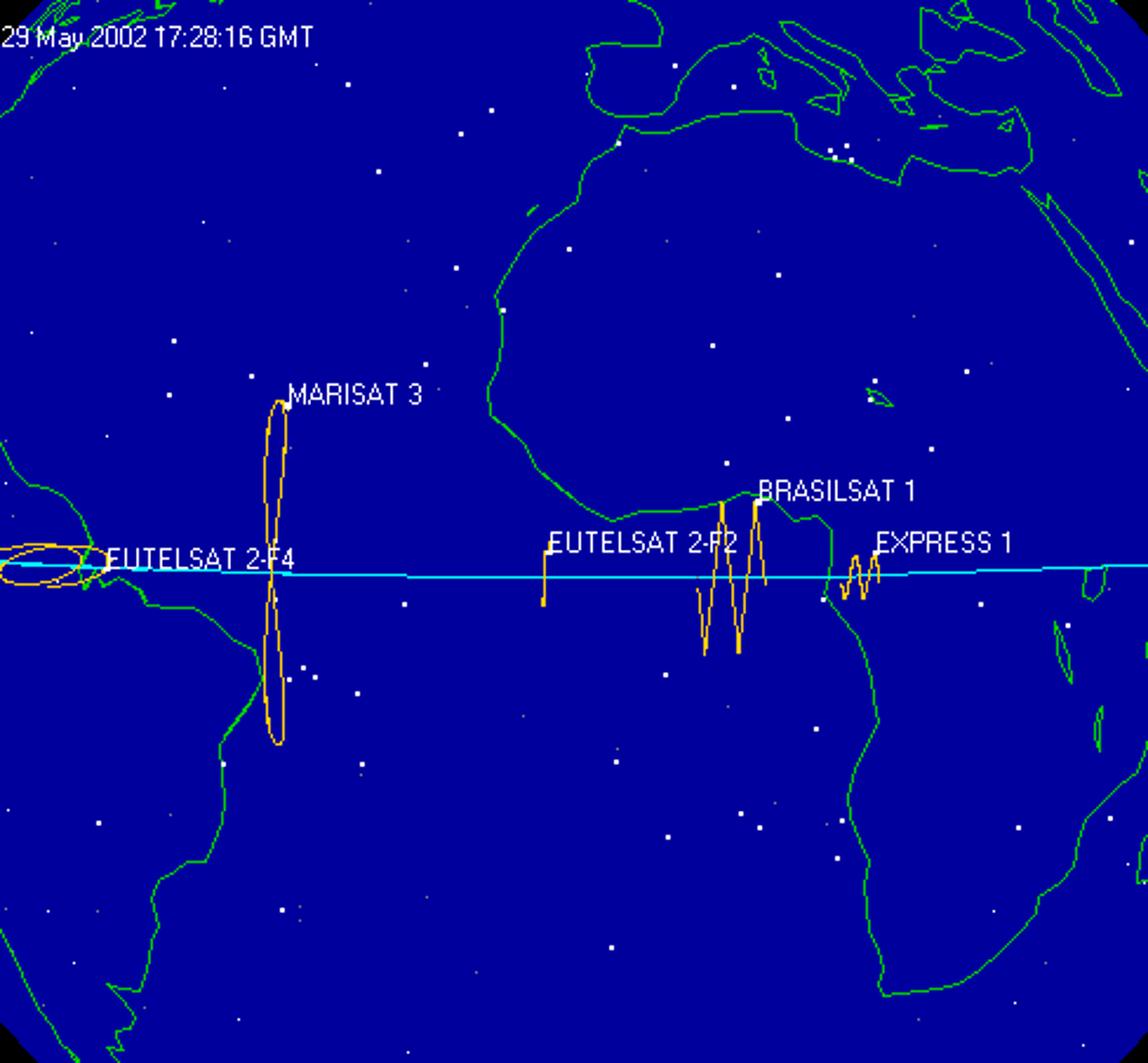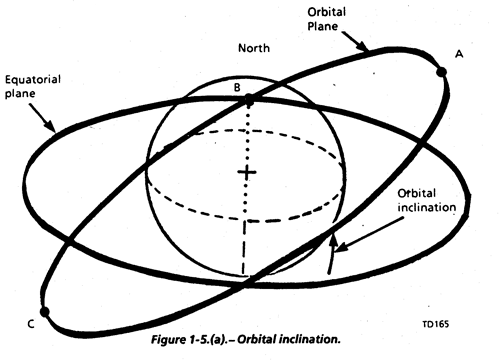


Science and Faith
Science and Faith
Catholic Outlook
Catholic Outlook

Catholic Outlook
Science and Faith
Science and Faith
__________ Recent Additions __________
Catholic Outlook
Catholic Outlook
Dialogue on Looping and
Zig-Zagging Satellites
(Part 3)
How the the apparent motion of geosynchronous
satellites proves that the earth rotates
Gary Hoge
__________ About this Dialogue __________
A continuation of my dialogue with Catholic geocentrist Bob Sungenis. My words are in black, and Bob’s are in blue.
Here’s the latest in Bob Sungenis’ increasingly far-fetched attempts to explain the “dancing satellites” shown below:

First, let me reiterate from a previous post that the gravitational force from the rotating stars (which is confirmed by the Lense-Thirring effect, and which Gary still has not addressed), and the gravitational force from the earth itself, both act upon the satellites.
The “Lense-Thirring effect” is an effect predicted by general relativity. Bob doesn’t believe in general relativity. Therefore, the Lense-Thirring effect is not available to him as an explanation for how satellites move the way they do in a non-relativistic, geocentric world. He can’t have it both ways. He can’t blast relativity as an absolute farce, and then appeal to it as the explanation of how satellites move.
Second: Let’s take a closer look at Marisat 3 which produces a figure-eight pattern. The reason it produces this pattern is that, first of all, its position with respect to the equator is about 10 degrees in inclination.
Only if it’s orbiting, which Bob denies. Remember, “inclination” is the angle between a satellites orbital plane and the plane of the equator:

Since the equilibrium of gravitational forces lies only on the equator, then any satellite which is inclined to any degree against the equator is going to produce some type of oscillation.
What makes Bob think there’s an “equilibrium of gravitational forces” that lies “only on the equator”? I think a lawyer would say this answer “assumes facts not in evidence.” Bob needs to substantiate claims like this, not just assert them as conclusions following words like “since” and “because.”
How would this occur in a Geocentric universe in which the satellite is not orbiting the earth but is merely hovering about the earth, moving only slightly?
Let me make an analogy. Let’s say you are in a room. On one side of the room there is a 1000 lb electro-magnet. On the other side there is a 100 lb electro-magnet. Both magnets are turned on and operating. There is a force from each magnet. Somewhere in the room, closer to the 100 lb magnet, there is an equilibrium of counter-acting magnetic forces, such that if a metal object were placed in that equilibrium, the metal object would remain suspended within the magnetic force. (There are plenty of experiments that do this very thing). To test this out, you place a steel ball in the equilibrium position between the two magnets. You see that the ball floats in mid air, suspended by the force of both magnets.
Okay, no problem so far.
Now, before I go any further, if you haven’t figured it out already, the 1000 pound magnet represents the force of gravity from the stars. The 100 pound magnet the force of gravity from the earth.
If Bob is planning to argue that geosynchronous satellites are floating in an equilibrium position between the earth (the 100 lb. magnet) and the stars (the 1,000 lb. magnet), he’s going to have to explain why the moon, which is way past this “equilibrium point,” doesn’t go zipping off toward the stars. How can it orbit the earth if its hundreds of thousands of miles on the stellar side of this alleged “equilibrium point”?
The steel balls represent the satellites. And one point of clarification before I proceed, the force of the stars, according to the Lense-Thirring Effect, is created by the billions of stars all acting upon the earth at the same time. These stars, as they rotate in their shell, produce large gravitational effects, according to the Lense-Thirring principle, supported by Einstein himself.
But Bob says Einstein’s theories are “an absolute farce.” Therefore, he can’t appeal to them to explain how things move in his non-relativistic, geocentric world.
This immense amount of stars makes up for the fact that the stars are far away. I say this to counter the idea that Gary was perpetuating that the stars have a negligible force on the earth.
Even if we assume that each star exerts tremendous force on us, the fact that we’re surrounded on all sides by such stars means the forces would cancel out and the net effect would be zero. That is especially true if, as Bob says, the earth is the center of the universe.
Now back to the analogy. You place a steel ball in the exact place where the equilibrium of the magnets exists. What do you see? The steel ball remains motionless. But on your second attempt, you place the steel ball just a little left or right of the equilibrium point. What are you going to see?
You’re going to see the ball accelerate toward the stronger magnet and smash into it. Once you move away from the equilibrium point, you move into an area where one magnet is stronger than the other. Therefore, the net force on the ball is going to pull it toward that magnet, as shown in this figure:

In the above figure, you can see that at the equilibrium point between the two magnets, the force of attraction on the ball is balanced, and therefore, as Bob says, the ball isn’t going to move. But if you move the ball closer to the 1,000 lb. magnet the force of attraction from the 1,000 lb. magnet is going to be stronger than the force of attraction from the 100 lb. magnet, and the ball will accelerate toward the 1,000 lb. magnet. (The same thing will happen, of course, if you move the ball closer to the 100 lb. magnet.)
You’re going to see the steel ball oscillate, left to right and right to left, indefinitely, because the unequal magnetic force on either side of it will constantly tug at it.
Nope, you’re going to see it accelerate toward the stronger magnet and smash into it. In order to oscillate, when you move the ball closer to the 1,000 lb. magnet, the force of attraction from the 100 lb. magnet would have to be stronger than the force of attraction from the 1,000 lb. magnet, in order to pull the ball back toward the equilibrium point. Obviously, that’s not the case, and therefore, oscillation is not physically possible in this scenario.
If you placed the steel ball just a little above the equilibrium point, then you would see it oscillate up and down, indefinitely. If on a diagonal, you would see it oscillate diagonally. This is precisely what is happening with the Geo satellites.
I’ve lost track: Is this Bob’s third or his fourth different attempt to account for the motion of geosynchronous satellites? It seems that each attempt is getting more absurd than the one before.
If they are not placed precisely on the equator, but are inclined to one degree or another, then they will show some type of oscillation, indefinitely. They will oscillate with respect to the equator, since the equator is the balance point where all the forces cancel each other out.
Here’s another one of those unfounded assertions preceded by the word “since.”
That is why all the diagrams Gary shows have the center point of the oscillation precisely on the equator.
No, the reason these satellites move an equal distance above and below the equator is because they are orbiting the earth in nearly circular orbits. As you can see from the above “inclination” figure, a satellite in such an orbit will always move equal distances above and below the equator. It has nothing to do with gravitational forces from the stars.
The reason they are oscillating is because of the differential gravity between the stars and the earth.
Even if that explanation made sense, which it doesn’t, it still doesn’t account for the zigzagging satellites. Why do they move in a slow and steady zigzag while the others don’t?
Now, you’ll notice in Gary’s list that the satellites have either a zig-zag or figure-eight pattern. Why are they different? Since the satellite is placed in an elliptical position, not a circular position, with respect to the earth, this means that the satellite cannot maintain its position unless it moves faster or slower against the inertial frame.
Wait a sec, I thought these satellites weren’t orbiting. What’s this talk about “elliptical” and “circular”? These satellites are supposedly just levitating up there, remember?
Thus, when the satellite is closest to the earth (the perigee) the satellite would be faster with respect to the inertial field (and from Gary’s perspective it would rotate around the earth in less than 24 hours); and when the satellite is farthest away from the earth (the apogee) the satellite would be moving slower with respect to the inertial field (or from Gary’s perspective it would take more than 24 hours to rotate around the earth).
Again, that’s only true if the satellite is in orbit. But Bob says it’s not orbiting, and therefore, he can’t appeal to the velocity differences at the perigee and apogee of an elliptical orbit. He needs to come up with an explanation that makes sense for an object that’s levitating, not orbiting.
This movement is going to create various patterns. The closer the semi-major axis of the orbit lies along the apogee-perigee line, the wider the figure-eight pattern will appear, since it will be oscillating with greater force.
What orbit? If these satellites are orbiting, then the earth is rotating. Are you ready to admit that they’re really orbiting, Bob?
When the semi-major axis lies along the equator, you will get neither a figure-eight nor a zig-zag, but you will get a slight north-south oscillation. You will get a zig-zag pattern when the semi-major axis is between the apogee-perigee line and the line of the equator. Or, to put it another way, when the period of the ellipses is slightly more or slightly less than 24 hours, you will get a zig-zag pattern.
Yep, if the satellite is orbiting.
In effect, the figure-eights and the zig-zags are being produced from the same effect, except the diameter of some of the loops is too small to show up in the computer graph, so they turn out as zig-zags rather than the larger figure-eights.
That’s exactly right. In my world. Bob, are you conceding that these satellites or orbiting in elliptical orbits having a period of approximately 24 hours, and that the earth is rotating beneath them?
Now, let me add one more dimension to this picture. Against what background is the figure-eight pattern or zig-zag pattern measured? In Gary’s universe it is measured against a rotating earth. In the Geocentric universe it is measured against a rotating star shell.
No, they move in figure-eights and zigzags relative to the surface of the earth, whether the earth is rotating or not. It’s just that if the earth’s not rotating, there’s no way to account for that motion, as Bob has amply demonstrated.
Let me explain: If the earth is stationary, the stars are rotating around the earth every 24 hours. They will come back to precisely the same point each 24 hour period (allowing a little movement for precession, which I don’t want to get into right now). We can see the satellites move against the background of the stars. On the first night we will see Marisat in a certain position against a particular star. But 24 hours later, we will see that Marisat did a figure-eight against the background of the star. (In case you’re wondering, it makes no difference whether the star rotates around the earth, because every 24 hours the star will always come back to the same position in the sky).
If we were at the equator, and if we were able to train our eyes on Marisat 3 for 24 hours, we’d see it move around our sky in a figure-eight pattern. That’s its motion relative to us. It has nothing to do with the stars. If we were somehow able to block our view of the stars and look only at Marisat 3, we’d still see it moving in a figure-eight pattern.
Is Marisat showing us real movement? Yes, it is real. Marisat is actually oscillating due to the fact that it is in a 10 degree inclination with respect to the earths equator. Being in that inclination, Marisat will experience opposing gravitational forces from the earth-star gravity field, and thus it must oscillate back and forth between the equilibrium point, which is at the equator.
Let us say, for the sake of argument, that these “opposing gravitational forces” were able to account for the north-south oscillation of Marisat 3. What accounts for its daily east-west oscillation? There can be no imbalance of forces parallel to the direction of rotation of the stars, so what makes Marisat 3 oscillate east-and-west? And what makes Brasilsat 1 move in a steady westerly direction?
But what does Marisat look like from Gary’s universe? Since for Gary the earth is rotating, then he cannot attribute the movement to an oscillation of the satellite itself, but to the rotation of the earth against the inclination of the satellite. That is why he says that the figure-eights are only there by “appearance.”
Yes, that way I don’t have to appeal to imaginary forces that control the movement of artificial satellites, but don’t effect the moon or the sun or the planets, all of which are allegedly able to orbit the earth every day, despite being well beyond the point of equilibrium between the gravitational forces of the stars and the earth. If Bob’s explanation were correct, every object beyond the equilibrium point where the geosynchronous satellites orbit – excuse me, levitate – should go flying off toward the stronger gravitational pull from the rotating shell of stars.
But does that prove the earth rotates? Not by any means. Since, as I have shown above, the same satellite movements can be explained from the perspective of a rotating star shell as much as they can be explained from a rotating earth. Thus, using the “movements” of the Geo satellites proves nothing for anyone. All it proves is the same thing I’ve been saying all along - there is no proof for a rotating earth as opposed to a rotating star shell.
And I’ll say what I’ve said all along. Bob’s latest attempt to account for the motions of these satellites is no more plausible than any of his previous attempts. In each case he has to appeal to relativistic forces, which he otherwise says are “an absolute farce,” and he has to appeal to orbital mechanics even though he claims these objects aren’t orbiting. What he has not been able to do is come up with a credible explanation for this motion without borrowing from sources he claims not to believe.
What I have in my favor, however, is that because of the Lense-Thirring principle, which was supported by Einstein himself (a position which I laboriously detailed in one of my earlier posts),
In which case he can’t use it, because he says Einstein’s relativity theories, from which the Lense-Thirring effect was derived, are “an absolute farce.” You can’t have it both ways, Bob.
then I have a viable PHYSICAL explanation for the forces that would cause Marisat to oscillate in the figure-eight pattern, and therefore my assertion that no one can disprove that system still stands; and which also means that no one can prove that a rotating earth is the only explanation.
I have proved that Bob’s latest explanation is no more viable than the others. I’m eager to see what he tries next.
Part 1, Part 2, Part 3, Part 4, Part 5
Copyright © 2024 Catholicoutlook.me
MENU